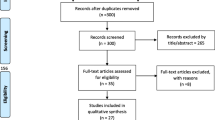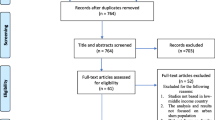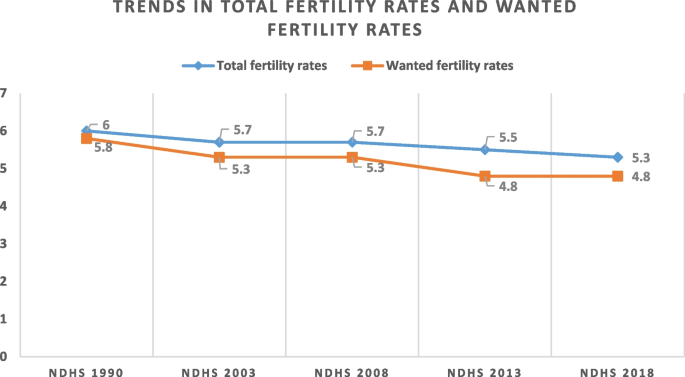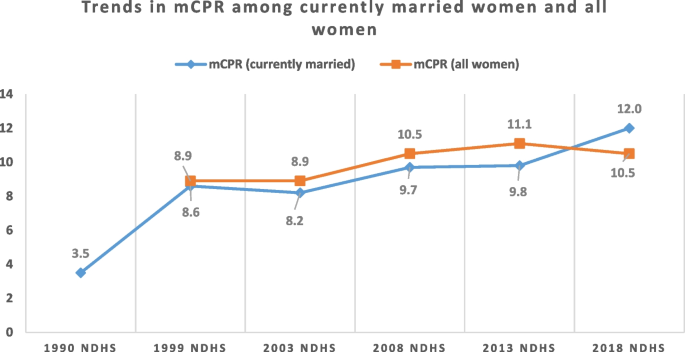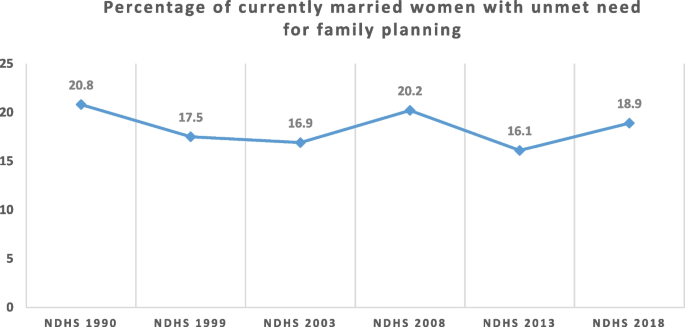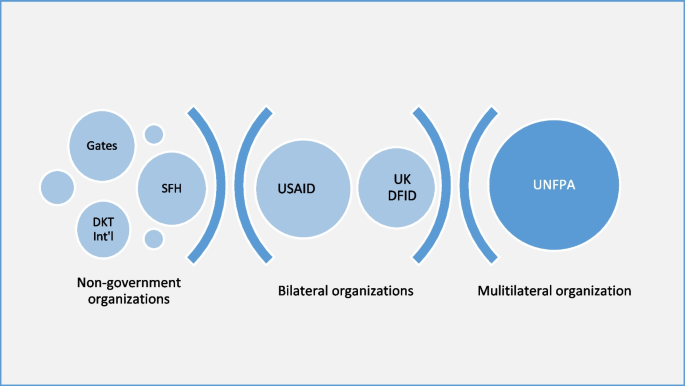Abstract
Background
Family planning (FP) is an important public health intervention that is proven to reduce unplanned pregnancies, unsafe abortions, and maternal mortality. Increasing investments in FP would ensure stability and better maternal health outcomes in Nigeria. However, evidence is needed to make a case for more domestic investment in family planning in Nigeria. We undertook a literature review to highlight the unmet needs for family planning and the situation of its funding landscape in Nigeria. A total of 30 documents were reviewed, including research papers, reports of national surveys, programme reports, and academic/research blogs. The search for documents was performed on Google Scholar and organizational websites using predetermined keywords. Data were objectively extracted using a uniform template. Descriptive analysis was performed for quantitative data, and qualitative data were summarized using narratives. Frequencies, proportions, line graphs and illustrative chart were used to present the quantitative data.
Although total fertility rate declined over time from 6.0 children per woman in 1990 to 5.3 in 2018, the gap between wanted fertility and actual fertility increased from 0.2 in 1990 to 0.5 in 2018. This is because wanted fertility rate decreased from 5.8 children per woman in 1990 to 4.8 per woman in 2018. Similarly, modern contraceptive prevalence rate (mCPR) decreased by 0.6% from 2013 to 2018, and unmet need for family planning increased by 2.5% in the same period. Funding for family planning services in Nigeria comes from both external and internal sources in the form of cash or commodities. The nature of external assistance for family planning services depends on the preferences of funders, although there are some similarities across funders. Irrespective of the type of funder and the length of funding, donations/funds are renewed on annual basis. Procurement of commodities receives most attention for funding whereas, commodities distribution which is critical for service delivery receives poor attention.
Conclusion
Nigeria has made slow progress in achieving its family planning targets. The heavy reliance on external donors makes funding for family planning services to be unpredictable and imbalanced. Hence, the need for more domestic resource mobilization through government funding.
Similar content being viewed by others
Explore related subjects
Discover the latest articles, news and stories from top researchers in related subjects.Background
More than 200 million women in developing countries want to avoid or delay pregnancy. Yet, they lack access to effective and safe family planning services [1]. In Nigeria, fewer than two out of every ten married women use modern contraceptives, and 19% of women have an unmet need for family planning [2]. The reasons for this include supply-side issues such as unavailability of FP services and information, and demand-side issues such as lack of funds and poor support from partners or communities [2]. Limited access to FP services prevents women of reproductive age from delaying pregnancy, limiting family size and safe spacing [3,4,5,6].
In order to address the socio-cultural issues that limit access to family planning services, the Federal government designed a strategy for engaging with stakeholders to discuss issues about large family size, religious beliefs, and women's power to make decision about their sexual and reproductive health [7]. This approach has been effective in addressing some of the cultural barriers to contraception and the increase in contraceptive use in some communities in Nigeria has been attributed to the involvement of community leaders to promote family planning [8].
Family planning (FP) is an important public health intervention that is proven to improve maternal and child health outcomes by reducing unplanned pregnancies and unsafe abortions [9,10,11,12,13]. To ensure progressive improvements in maternal and child health outcomes through family planning, there is need for sustained and dedicated funding of family planning programmes [14, 15]. Evidence from the United States international family planning assistance in 2014 showed that investments in family planning services and contraceptive supplies saves millions of lives [16]. Through improving access to contraceptives for 30 million women and couples, 7 million unintended pregnancies, 2 million unsafe induced abortions and 13 thousand maternal deaths were averted [16].
In Nigeria, the national budget for family planning was cut short by 90% in 2019, owing to lack of counterpart funding to match grants from donors [17]. This resulted in the stock-out of contraceptive commodities in the primary health centers, and worsened access to family planning services for women [18]. Moreover, with the withdrawal of donor funds, domestic resource mobilization (DRM) for family planning services and contraceptive supplies became an urgent need for the Reproductive, Maternal, Newborn, Child and Adolescent Health (RMNCAH) program in Nigeria to improve [2]. Granted that increasing investments in FP would ensure stability and better maternal health outcomes in Nigeria, evidence is needed to make a case for more domestic investment in family planning.
Evidence generation is a critical component of the National and State roadmaps for improved domestic resource mobilization for family planning in Nigeria [19], and reliable evidence is needed to motivate policymakers and domestic funders to allocate more resources towards family planning services and contraceptive supplies. Therefore, we undertook a literature review to determine the unmet needs for family planning and analyze the funding landscape in Nigeria, with a view to highlight the need for increased domestic funding of family planning services. The findings will be invaluable to policymakers and family planning program officers in advocating for domestic funding for family planning interventions.
We undertook a narrative review of literature from February to May 2022 to generate evidence that showcases the need to allocate more domestic funds to family planning services in Nigeria.
Our review sought to answer two key questions,
-
1.
What is the unmet need for family planning in Nigeria?
-
2.
How is the family planning programme in Nigeria funded, and what does this imply for reliability and predictability of funding?
Main text
To answer these questions, we analyzed the trends in fertility rate and contraceptive prevalence rate from 1990 to 2018 and estimated the gaps in wanted and actual fertility. Then we undertook a funding landscape analysis using the bespoke framework that highlights the types and characteristics of funding organizations (in terms of reliability and predictability), as well as their interests or areas of funding.
Document search
Electronic search was performed on Google Scholar, organizational websites and blogs to source for relevant documents, such as peer-reviewed articles, reports from national surveys, and reports from family planning programmes and interventions.
The reports from the Nigeria Demographic and Health Survey (NDHS) were collated from 1990 to 2018, while the reports for the Multiple Indicators Cluster Survey (MICS) were collated for 1999 to 2016. Peer-reviewed journal articles and website articles that were published in English language from January 2008 to June 2021 were included in the review, and the scope of the review was limited to Nigeria only. The search for articles was performed using various combination of key terms including, “family planning”, “contraceptives”, “fertility rate”, “contraceptive prevalence rate”, “financing”, “funding landscape”, “funders”, “unmet need”, “unwanted pregnancy”, “family planning investment”.
A total of 30 documents were reviewed including, 16 journal articles, ten web blogs, and six national survey reports [2, 7, 8, 19,20,21,22,23,24,25,26,27,28,29,30,31,32,33,34,35,36,37,38,39,40,41,42,43,44,45,46,47].
Data extraction and synthesis
Data were objectively extracted by two independent researchers using a uniform template that was designed in Microsoft Excel.
The template was structured according to themes, including a description of the article under review, and the findings from the review were synthesized according to the thematic areas, namely,
-
Fertility rates
-
Contraceptive prevalence rates
-
Variations in fertility and contraceptive prevalence rates
-
Nature of funding, including
-
◦ Name and type of funding organization
-
◦ Interest of funding organization (areas/aspects of family planning services that are funded)
-
◦ Type of funding (e.g., grant, loan)
-
◦ Duration of funding
-
◦ Funding route (e.g., third party financing, direct facility financing, etc.)
-
◦ Conditions of funding (e.g., counterpart funds, results-based)
-
Narrative summaries are presented for the qualitative data. Proportions are reported for quantitative data.
Results
Trends in fertility rates
Figure 1 shows that the total fertility rate in Nigeria has gradually declined over time from 6.0 children per woman in 1990 to 5.3 in 2018, and that the wanted fertility rate has decreased from 5.8 children per woman in 1990 to 4.8 per woman in 2018 [2, 20,21,22,23,24].
However, the gap between wanted fertility and actual fertility has increased over time from 0.2 in 1990 to 0.5 in 2018. This signifies that a Nigerian woman has 0.5 more children than she wants to have.
Trends in contraceptive prevalence rate and unmet need for family planning
As shown in Fig. 2, modern contraceptive prevalence rate (mCPR) improved from 3.5% in 1990 to 12.0% in 2018, which indicates an increase of 8.5% in 28 years [2, 20,21,22,23,24].
This translates to a yearly increase of 0.3%, which if sustained will not result in the achievement of the country’s mCPR target of 27% by 2024 [19].
Even though mCPR is traditionally reported for currently married women, it is noteworthy that mCPR among all women decreased from 11.1% in 2013 to 10.5% in 2018.
Figure 3 shows that the unmet need for family planning among currently married women reduced by 3.9% in 2003 and increased by 3.3% in 2008; and has since followed the pattern of falling and rising. Between 2013 and 2018, unmet need for family planning increased by 2.8% [2, 21].
Geographic variations in fertility and contraceptive prevalence rates
Over time, total fertility rate has been consistently higher in the rural areas compared to the urban areas, whilst mCPR has been higher in urban areas than in rural areas, expectedly.
Wide variations in TFR are also seen across geopolitical zones, with the northern zones having substantially higher rates than the south. It is noteworthy that over the years, the southern zones have consistently had lower fertility rates than the national average. Women in the north-east and north-west geopolitical zones reported having an average of two more children than their counterparts in the south.
Regarding contraceptive prevalence, there are wide regional variations in mCPR across the geopolitical zones and the States. The northern zones have consistently reported lower mCPR than the south, and the north-east and north-west geopolitical zones have had the lowest mCPR in the north.
These geographic disparities in fertility rates and mCPR are summarized in Tables 1 and 2, respectively.
Funding landscape for family planning in Nigeria
Federal Government Budgetary Allocation to Family Planning (2015 to 2020)
Family planning was not an item in budgets before 2015. Allocation by federal government to FP was on the increase from 2015 when line listing for family planning commenced in the national budget. However, there was a sharp decline in 2019 due to the removal of counterpart funding to match grants from international donor agencies which was budgeted for in 2018. See Table 3 below.
Typologies of funding organization
Funding for family planning services in Nigeria comes from both external and internal sources in the form of cash (grants or loans) or commodities. Internal sources of funding include the Federal and State governments, while external sources include multilateral and bilateral international organizations, and international Non-Governmental Agencies.
The key international and donor agencies that fund family planning services in Nigeria are shown in Fig. 4, and the size of the circle indicates the relative contribution of the funder to family planning services in Nigeria.
UNFPA is the major funder of family planning services in Nigeria, followed by the USAID. UNFPA provides family planning assistance in 19 States plus the Federal capital territory (FCT), while USAID partners with a variety of non-governmental and community-based organizations across the 36 States and the FCT [31].
Nature of funding (type, duration, routes and conditions for funding) for family planning
The nature of external assistance for family planning services depends on the preferences of funders, and whether the funding is in form of cash or commodities. External assistance in the form of grants and loans are typically provided to only Federal or State governments, while commodities are provided to public and/or private health facilities through government agencies or implementing partners.
Table 4 shows some similarities and variations among funding agencies in funding for family planning services. With the exclusion of the Saving One Million Lives Programme for Results (SOML PforR), government funding for family planning has been in the form of annual budgetary allocations. Whereas funding from external donors has been in the form of grants. Irrespective of the type of funder and the length of funding, donations/funds are renewed on annual basis.
Various funding routes are employed by external donors, notably the supply of family planning commodities through the State governments or through implementing partners.
Counterpart funding and output-based financing are the two most common conditions for funding.
Interests of funding organization (areas/aspects of family planning services that are funded)
The areas or aspects of family planning services that are funded by international organizations and non-government agencies include, (i) procurement of commodities; (ii) distribution and supply chain management (SCM); (iii) training of health workers; (iv) demand creation and community mobilization; (v) other advocacy interventions; and (vi) research. Whereas, government funding is used to procure and distribute commodities, and pay the salaries of health workers.
Table 5 shows that procurement of commodities receives the most attention for funding, while demand creation and research receive the least attention. It is also noteworthy that although State governments are primarily responsible for the distribution of commodities, many States do not allocate or release funds for this purpose. Hence, it can be said that this critical aspect of family planning services is very poorly attended to in Nigeria, and this may well explain the problems of unavailability of commodities at service points.
The Nigerian government maps out funds for the procurement and distribution of FP commodities to States. About US$4 million was approved in 2021 for the procurement of family planning commodities [32].
The UNFPA is primarily involved in the procurement of family planning commodities for the public sector. It also provides technical assistance to focus States in the form of training of health workers [26].
The U.S. Agency for International Development (USAID) is a bilateral organization that partners with NGOs to provide FP commodities to both public and private healthcare providers. It also funds programs that seek to improve the quality of FP services and to hold State governments’ accountable to ensuring that FP commodities reach the last mile [25, 26]. The efforts of the USAID-funded Health Policy Plus’ advocacy to Cross-River State government resulted in the allocation of $600,000 for the distribution and security of FP commodities in 2013 and 2014 [25].
The (UK) Department for International Development (DFID) provides the majority of the FP commodities that are supplied to private healthcare providers in Nigeria [27].
Society for Family Health (SFH) and DKT International are social marketing organizations that provide and distribute FP commodities to private facilities [25, 27, 30]. They are also involved in advocacy and training of health workers with primary focus on private providers [26, 30].
Marie Stopes International offers a wide range of sexual and reproductive health services including FP to communities in urban locations, and it has become a major provider of long acting and permanent contraception in health facilities. The organization delivers FP services through static clinics, mobile outreach teams and social franchising [46, 47].
The Gates Foundation focuses on the public sector, and its donations have been used to procure FP commodities [26]. Through the funding that was provided for the Nigeria Urban Reproductive Health Initiative (NURHI), access to FP commodities and services increased in the six intervention cities, resulting in an increase of mCPR by 20% in three years [8, 26, 29].
Conclusions
Ensuring that every sexually active woman in Nigeria has access to high-quality family planning and contraceptive services is imperative as it save lives and promotes positive maternal health outcomes. Our review highlights that Nigeria’s progress in achieving the targets of family planning has been slow and inconsistent, owing to poor government funding of family planning services. Additional to inadequate government funding of family planning intervention in Nigeria, there is a very wide gap between the estimated cost and the actual allocation of funds for procurement and distribution of family planning commodities [37]. For instance, between 2012 and 2016, the Federal government fulfilled only 11% of its FP2020 pledge to provide US$3 million annually for the procurement of family planning commodities [37].
According to the 2016 Appropriation Act, the government is referred to as provider of “counterpart” funding for family planning [37, 48]. This means that while donors serve as principal sources of funds, the government serves as a secondary funder of family planning intervention. However, with the ongoing withdrawal of donors and decline in donor contributions, there is a need for government to take on the role of principal funder of family planning in Nigeria [49, 50].
Although the Federal government prioritizes family planning interventions by making provisions in the annual budget and earmarking funds through special interventions (such as the SOML-PfR), the funding landscape for family planning interventions at the subnational level is dominated by external donations which are short-lived, unpredictable (in terms of amount and timing), and focused on a single area which is the procurement of commodities [51]. The nature of external funding influences subnational planning and effective implementation of family planning services. Program managers find it difficult to make or execute plans when they cannot rely on the amount of money or quantity of commodities that will be available. Moreover, the only guarantee that family planning commodities will reach the last mile of distribution is that State governments honor their commitments to funding the distribution and supply chain management system.
Currently, State governments feature minimally in the funding for family planning services, as service delivery is primarily driven by the commodities supplied by external donors and the fee-for-service payments that are made by clients [37]. The health budgets of many States in the country lump family planning intervention with reproductive health, and this increases the likelihood that family planning services will be overlooked in the budgetary allocations. The ongoing global advocacy for programme-based budgeting as a tool for increasing transparency, accountability and data-driven decision making, provides an opportunity for family planning to be categorized as a stand-alone programme.
Evidence from this review validates the need for the Federal and State governments, particularly, to step-up and take on a greater share of the responsibility for financing family planning intervention, including the procurement and supply of commodities, and service delivery. The advent of the Basic Health Care Provision Fund in Nigeria in which one percent of consolidated revenue fund is earmarked for provision of health services at the primary health care level provides an opportunity for further earmarking a percentage of this fund for family planning at the primary and local government levels. Domestic funding of FP can further be improved by earmarking at least one percent of the annual health budget to funding of FP programs.
However, this is a review article, and the findings may have been influenced by the following factors, (i) the personal viewpoints of the reviewers; (ii) the omission of relevant research due to literature search procedures; and (iii) errors in the translation of data from the primary source. Moreover, the estimates presented in this paper should be interpreted with caution since some of them are based on older available data.
In conclusion, Nigeria has made slow progress in achieving its family planning targets. Over a period of 28 years, total fertility rate declined by 0.7 children per woman, wanted fertility rate decreased by 1, and the gap between wanted fertility and actual fertility increased by 0.3. Over a five-year period, mCPR decreased by 0.6%, and unmet need for family planning increased by 2.5%. Nigeria still relies heavily on external donations for family planning intervention. This makes funding for family planning services to be unpredictable and imbalanced. This highlights the need for increased budgetary allocation and actual release of funds for FP interventions at national and subnational levels. Improving domestic resource contributions to family planning would contribute to improvements in service delivery, because more funds will be available to ensure procurement and uninterrupted supply of sufficient amounts of contraceptive commodities to the last mile. These findings are invaluable to policymakers and family planning program officers for advocating for more funding for family planning interventions. A detailed financial analysis is required to identify opportunities to leverage within the fiscal space to mobilize resources for family planning. Family planning programme managers will also require capacity building on how to use evidence to advocate for more domestic resources for family planning.
Availability of data and materials
The study dataset is available on request.
Abbreviations
- FP:
-
Family Planning
- mCPR:
-
Modern Contraceptive Prevalence Rate
- DRM:
-
Domestic resource mobilization
- UNFPA:
-
United Nations Fund for Population Activities
- SOML PforR:
-
Saving One Million Lives Programme for Results
- USAID:
-
United States Agency for International Development
- DFID:
-
Department for International Development
- SFH:
-
Society for Family Health
References
Family planning. [https://www.unfpa.org/family-planning]
National Population Commisison (NPC) [Nigeria], ICF Macro. Nigeria Demographic and Health Survey 2018. Abuja, Nigeria, and Rockville, Maryland, USA: NPC and ICF; 2019.
Sinai I, Omoluabi E, Jimoh A, Jurczynska K. Unmet need for family planning and barriers to contraceptive use in Kaduna, Nigeria: culture, myths and perceptions. Cult Health Sex. 2020;22(11):1253–68.
Girma Garo M, Garoma Abe S, Dugasa Girsha W, Daka DW. Unmet need for family planning and associated factors among currently married women of reproductive age in Bishoftu town, Eastern Ethiopia. PLoS One. 2021;16(12):e0260972.
Phiri M, Odimegwu C, Kalinda C. Unmet Need For Family Planning Among Married Women. In: Sub-Sahara Africa: A Meta-Analysis of DHS Data (1995–2020). 2022.
Pasha O, Goudar SS, Patel A, Garces A, Esamai F, Chomba E, Moore JL, Kodkany BS, Saleem S, Derman RJ, et al. Postpartum contraceptive use and unmet need for family planning in five low-income countries. Reprod Health. 2015;12(2):S11.
FP2020: Over 6.5 million women now use a modern method of contraception in Nigeria. . In. Abuja, Nigeria; 2019. Accessed from: https://www.familyplanning2020.org/news/over-65-million-women-now-use-modern-method-contraception-nigeria
Krenn S, Cobb L, Babalola S, Odeku M, Kusemiju B. Using behavior change communication to lead a comprehensive family planning program: the Nigerian Urban Reproductive Health Initiative. Glob Health Sci Pract. 2014;2(4):427–43.
Aliyu AA: Family planning services in Africa: The successes and challenges. Family Planning 2018, 69.
Perry HB, Rassekh BM, Gupta S, Wilhelm J, Freeman PA: Comprehensive review of the evidence regarding the effectiveness of community–based primary health care in improving maternal, neonatal and child health: 1. rationale, methods and database description. J Glob Health 2017, 7(1):010901
Brown W, Ahmed S, Roche N, Sonneveldt E, Darmstadt GL. Impact of family planning programs in reducing high-risk births due to younger and older maternal age, short birth intervals, and high parity. Semin Perinatol. 2015;39(5):338–44.
Winikoff B, Sullivan M. Assessing the role of family planning in reducing maternal mortality. Stud Fam Plann. 1987;18(3):128–43.
Tsui AO, McDonald-Mosley R, Burke AE. Family planning and the burden of unintended pregnancies. Epidemiol Rev. 2010;32(1):152–74.
Starbird E, Norton M, Marcus R. Investing in family planning: key to achieving the sustainable development goals. Glob Health Sci Pract. 2016;4(2):191–210.
Osotimehin B. Family planning save lives, yet investments falter. The Lancet. 2012;380(9837):82–3.
Guttmacher Institute. Just the Numbers: The Impact of U.S. International Family Planning Assistance. 2014.
Advance Family Planning: Nigeria’s national family planning allocation cut by 90%. Baltimore: Johns Hopkins University; 2017a. Retrieved from https://www.advancefamilyplanning.org/nigerias-national-family-planning-allocation-cut-90.
USAID: Ensuring Access to Family Planning in Nigeria. Health Policy Project; March, 2015. Retrieved from: https://2012-2017.usaid.gov/results-data/success-stories/ensuring-sustainable-access-family-planning-cross-river-state-nigeria.
Federal Ministry of Health (FMOH): Nigeria family planning blueprint 2020–2024. Abuja, Nigeria: FMOH. 2020. Retrieved from https://www.health.gov.ng/doc/Final-2020-Blueprint.pdf.
National Population Commission (NPC) [Nigeria] and ICF Macro. Nigeria Demographic and Health Survey 2008. Abuja: National Population Commission and ICF Macro; 2009.
National Population Commission (NPC) [Nigeria], ICF International: Nigeria Demographic and Health Survey 2013. In. Abuja, Nigeria, and Rockville, Maryland, USA; 2014.
National Population Commission (NPC) [Nigeria]. Nigeria Demographic and Health Survey 1999. Calverton, Maryland: National Population Commission and ORC/Macro; 2000.
National Population Commisison (NPC) [Nigeria], ORC Macro. Nigeria Demographic and Health Survey 2003. Calverton, Maryland: National Population Commission and ORC Macro; 2004.
National Bureau of Statistics, United Nations Children’s Fund, United Nations Population Fund. Nigeria Multiple Indicator Cluster Survey 2011 Main Report. In. Abuja, Nigeria; 2013. Retrieved from: https://www.unicef.org/nigeria/reports/nigeria-multiple-indicator-cluster-survey-mics-2011.
USAID: Ensuring Access to Family Planning in Nigeria. . In., vol. 2021; Information released online from June 2012 to September 2017. Accessed from: https://2012-2017.usaid.gov/results-data/success-stories/ensuring-sustainable-access-family-planning-cross-river-state-nigeria
Akutson SK, Zubair AK, Akutson L. Business Case Framework for Investment in Reproductive Health in Nigeria. J Glob Econ Bu. 2020;1(2):1–16.
Marie T, Ness S, Amanyeiwe U, Adinma E, Ebenebe U, Nweje A: Nigeria: Reproductive Health Commodity Security Situation Analysis. . In., vol. Task Order 1. Arlington, Va: USAID | DELIVER PROJECT; 2009 https://docplayer.net/22229105-Nigeria-reproductive-health-commodity-security-situation-analysis.html
Speizer IS, Guilkey DK, Escamilla V, Lance PM, Calhoun LM, Ojogun OT, Fasiku D. On the sustainability of a family planning program in Nigeria when funding ends. PLoS One. 2019;14(9):e0222790.
Fotso JC, Ajayi JO, Idoko EE, Speizer I, Fasiku DA, Mberu B, Mutua M. Family planning and reproductive health in urban Nigeria: levels, trends and differentials. Chapel Hill: Measurement, Learning & Evaluation (MLE) Project [UNC, USA] and National Population Commission (NPC)[Nigeria]; 2011. 201(1). Retrieved from: https://www.researchgate.net/publication/262640101_Family_Planning_and_Reproductive_Health_in_Urban_Nigeria_Levels_Trends_and_Differentials#fullTextFileContent.
Nigeria: DKT International [https://www.dktinternational.org/country-programs/nigeria/]
Partnerships and Projects [https://www.usaid.gov/global-health/health-areas/family-planning/partnerships-projects]
Ihejirika PI, Ibeh R: Nigeria: Donor Funding for Family Planning Declines By $10m in 3 Years. In: Leadership. Abuja, Nigeria; 2022. Accessed from: https://allafrica.com/stories/202203160045.html
Changing attitudes to contraception. In: The New Humanitarian. 2011. Accessed from: https://www.thenewhumanitarian.org/report/93340/nigeria-changing-attitudes-contraception
Marie T, Ness S, Amanyeiwe U: Nigeria: Reproductive Health Commodity Security Situation Analysis: Kano. Arlington, Va: USAID | DELIVER PROJECT, Task Order 1; 2008. https://pdf.usaid.gov/pdf_docs/PA00MKKB.pdf
Nigeria Health Watch. The Gates Foundation and UNFPA pledge US3.1bn towards widening access to life-saving family planning at the global event to mark the next decade of the FP2030 partnership. Nov. 19, 2021. Accessed from: https://nigeriahealthwatch.com/the-gates-foundation-and-unfpa-pledge-us3-1bn-towards-widening-access-to-life-saving-family-planning-at-the-global-event-to-mark-the-next-decade-of-the-fp2030-partnership/
BILL & MELINDA GATES foundation. Family Planning. Accessed from: https://www.gatesfoundation.org/our-work/programs/global-development/family-planning
Jurczynska K. Evidence and Advocacy: Unlocking Resources for Family Planning in Nigeria. In: Policy brief. Washington, DC: Palladium, Health policy plus (HP+); 2017.
Odusina E, Ugal D, Olaposi O. Socio-economic status, contraceptive knowledge and use among rural women in Ikeji Arakeji, Osun State. Nigeria Afro Asian J Soc Sci. 2012;3:1–10.
Oluwaseun OJ, Babatola B, Gbamisola A. Determinants of Contraceptives among female adolescents in Nigeria. Department of demography and social statistics: Federal university, Oye-Ekiti, Nigeria; 2016.
Ogboghodo E, Adam V, Wagbatsoma V. Prevalence and determinants of contraceptive use among women of child-bearing age in a rural community in southern Nigeria. J Commun Med Prim Health Care. 2017;29(2):97–107.
Adebowale SA, Adeoye IA, Palamuleni ME. Contraceptive use among Nigerian women with no fertility intention: interaction amid potential causative factors. Afr Popul Stud. 2013;27(2):127–39.
Unumeri G, Ishaku S, Ahonsi B, Oginni A: Contraceptive use and its socio-economic determinants among women in North-East and North-West Regions of Nigeria: a comparative analysis. African Population Studies 2015, 29(2).
Solanke BL. Factors influencing contraceptive use and non-use among women of advanced reproductive age in Nigeria. J Health Popul Nutr. 2017;36(1):1–14.
Johnson OE. Determinants of modern contraceptive uptake among Nigerian women: evidence from the national demographic and health survey. Afr J Reprod Health. 2017;21(3):89–95.
Ononokpono DN, Odimegwu CO, Usoro NA. Contraceptive use in Nigeria: does social context matter? Afr J Reprod Health. 2020;24(1):133–42.
Duvall S, Thurston S, Weinberger M, Nuccio O, Fuchs-Montgomery N. Scaling up delivery of contraceptive implants in sub-Saharan Africa: operational experiences of Marie Stopes International. Global Health Sci Pract. 2014;2(1):72–92. https://doi.org/10.9745/GHSP-D-13-00116.
Marie Stropes Nigeria: https://www.mariestopes.org.ng/
Federal Government of Nigeria. 2016 Appropriation Act In. Abuja, Nigeria; 2016. Retrieved from: https://www.budgetoffice.gov.ng/pdfs/2016app/Works%20Power%20Housing.pdf.
Sathar Z. Best Bets: Additional Funding for Family Planning—International evidence on financing of family planning. Islamabad, Pakistan: Population Center; 2020.
Centre for Research Evaluation Resources and Development, Bayero University Kano. Family Planning Brief. In. September 26, 2018. Retrieved from: https://www.pmadata.org/sites/default/files/data_product_results/PMA2020-Nigeria-Taraba-R3-FP-Brief.pdf.
Mbachu C, Agu I, Ekwueme C, Eze I, Obayi C, Onwujekwe O. Identifying Innovative Approaches to Increase Domestic Resource Mobilization and Financing Contributions for Family Planning in Nigeria. North Carolina: University of North Carolina; 2022. p. 25.
Acknowledgements
Not applicable.
Funding
The project leading to the literature review has received funding from the Data for Impact (D4I) associate award 7200AA18LA00008, which is implemented by the Carolina Population Center at the University of North Carolina at Chapel Hill with the support of the United States Agency for International Development (USAID). The funder did not participate in the literature review, data analysis, or writing and reviewing the manuscript. The views presented in this manuscript belong solely to the authors and do not necessarily represent the funders’ views.
Author information
Authors and Affiliations
Contributions
CM and OO conceived the study. CM, IA and CE designed the protocol for the literature review. CM, IA and CE were involved in data extraction. All authors participated in data analysis. CM, IA and CE wrote the first draft of the manuscript. All authors reviewed and approved the final version for journal submission.
Corresponding author
Ethics declarations
Ethics approval and consent to participate
Not applicable.
Consent for publication
Not applicable.
Competing interests
Authors declare that there are no competing interests.
Additional information
Publisher’s Note
Springer Nature remains neutral with regard to jurisdictional claims in published maps and institutional affiliations.
Rights and permissions
Open Access This article is licensed under a Creative Commons Attribution 4.0 International License, which permits use, sharing, adaptation, distribution and reproduction in any medium or format, as long as you give appropriate credit to the original author(s) and the source, provide a link to the Creative Commons licence, and indicate if changes were made. The images or other third party material in this article are included in the article's Creative Commons licence, unless indicated otherwise in a credit line to the material. If material is not included in the article's Creative Commons licence and your intended use is not permitted by statutory regulation or exceeds the permitted use, you will need to obtain permission directly from the copyright holder. To view a copy of this licence, visit http://creativecommons.org/licenses/by/4.0/. The Creative Commons Public Domain Dedication waiver (http://creativecommons.org/publicdomain/zero/1.0/) applies to the data made available in this article, unless otherwise stated in a credit line to the data.
About this article
Cite this article
Mbachu, C.O., Agu, I.C., Ekwueme, C.N. et al. A narrative review of evidence to support increased domestic resource mobilization for family planning in Nigeria. BMC Women's Health 23, 235 (2023). https://doi.org/10.1186/s12905-023-02396-y
Received:
Accepted:
Published:
DOI: https://doi.org/10.1186/s12905-023-02396-y


